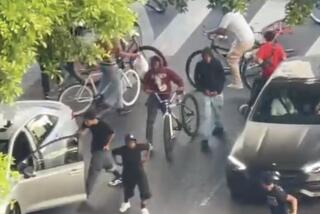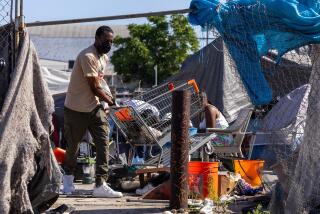Brutality against the homeless is increasing
- Share via
ORLANDO, FLA. — It was a balmy night, the sort that brings the homeless out from the shelters, when the police were summoned to America Street. On the driveway of a condo, just a few paces from the gutter, a man lay dying.He looked to be 50-ish and a resident of Orlando’s streets, judging by the moldy jacket. He had been bludgeoned so badly that he could hardly move.
Before being rushed to the hospital, where he died of head injuries, the man, August Felix, described his attackers. Young fellows did it, he whispered to the officers. Kids.
Within three months, two 16-year-olds and three 15-year-olds had been charged with second-degree homicide in the March 26, 2006, attack. The motive? “I don’t think there was a motive,” said Sgt. Barbara Jones, a police spokeswoman, “other than, ‘Let’s beat someone up.’ ”
That high-schoolers allegedly had turned into executioners on a whim brought pause to city officials and advocates for the homeless, not just because the killing was unprovoked, but because it fit into a trend: a nationwide surge in violence, largely by teenagers and young adults, against some of America’s most vulnerable residents.
A 2006 report by the National Coalition for the Homeless found 142 attacks last year against homeless people, 20 of which resulted in death -- a 65% increase from 2005, when 86 were violently assaulted, including 13 homicides.
By comparison, 60 such attacks were reported in 1999.
These numbers are probably low because they only reflect the most egregious attacks reported, according to Michael Stoops, acting executive director of the Washington-based coalition -- the only entity that gathers such data.
The trend is particularly troubling, he says, because the attacks no longer occur only in major cities on the East and West coasts, as was the case in the 1980s.
In its most recent study, “Hate, Violence, and Death on Main Street USA,” the coalition documented attacks against the destitute in 62 communities last year alone, in 26 states. Since 1999, such violence has occurred in 44 states and Puerto Rico, and in 200 communities nationwide.
An overwhelming majority of the attackers -- 88% -- were 25 or younger; 95% were male. No less than 68% of those accused and convicted in attacks were between the ages of 13 and 19.
This pattern of violence, in Stoops’ view, hasn’t gotten the attention it deserves.
“Homeless people are the newest minority group in America that is OK to hate and hurt,” he said. “It’s as though, somehow, they’re viewed as less deserving, less human than the rest of us.”
Americans did pay attention to the story of 58-year-old Jacques Pierre, a homeless man who’d been sleeping on a bench on a college campus when three teenagers woke him, taunted him, then nearly killed him with baseball bats.
Why?
That Jan. 12, 2006, attack in Fort Lauderdale was filmed by a surveillance camera and broadcast worldwide.
“For once,” says Sean Cononie, who operates a homeless shelter in that seaside city, “Americans saw with their own eyes how kids hunt down and kill homeless people as though it were a sport.”
Other cases:
* In Toms River, N.J., five high-school students were charged with beating a 50-year-old homeless man nearly to death with pipes and baseball bats -- throwing hockey pucks at him for good measure -- as he slept in the woods.
* In Butte, Mont., a 53-year-old homeless man was killed at a Greyhound bus depot because he refused to give another man a cigarette, according to court records. The victim’s skull was fractured.
* In Spokane, Wash., a one-legged, 50-year-old homeless man was set afire in his wheelchair on a downtown street; he died of his burns. Police charged a 22-year-old man with first-degree murder.
* In Nashville, Tenn., a homeless woman sleeping on a boat ramp was shoved into the Cumberland River, according to witnesses. Two men were charged with homicide in her drowning; authorities say the attack was unprovoked.
Cononie, who also publishes a monthly newspaper, “The Homeless Voice,” reported another trend: “Kids are even starting to videotape themselves hurting homeless people. That’s something we never saw before.”
He was referring to a February incident in Corpus Christi, Texas, in which a 22-year-old, a 16-year-old and a 15-year-old describe on camera how they are going to assault a homeless man.
On the tape, the attackers kick the man in the back, grab him, and flip him around to show off his injuries, according to police. The camera, which had been stolen, was recovered by the owner, who called police once she saw the footage.
Police have arrested one of the teens and are looking for the other two. The victim suffered a concussion but survived.
Some perpetrators are even younger. In late March, a homeless day laborer was walking at night through a neighborhood of Daytona Beach, Fla., when three boys on bicycles attacked him, striking him with a concrete block.
Two of the boys were 10; the third was 17. Each has been charged with aggravated battery. “For a 10-year-old to pick up a cinder block and smash somebody’s face with it, that defies logic,” Michael Chitwood, Daytona’s police chief, later told a reporter.
Though for the past decade assaults on the homeless have dotted the U.S. map, Florida is the state where such attacks are most frequent by far, the coalition’s February report says.
Last year, the coalition documented 48 attacks in Florida, where 60,867 of the state’s 17.8 million residents are homeless, according to federal figures. By comparison, 11 attacks were counted in California, where 170,270 of that state’s 36 million people are homeless.
Though some investigators think the attacks are random, Sgt. Richard Ring, who investigated the murder of August Felix in Orlando last year, sees “a more deep-seated problem here.”
As he puts it, “Our young people get prejudices from their parents in regard to homeless people. They don’t identify with the homeless, and they don’t seem to see them as important.” With Felix, Ring adds, “the juveniles targeted him because he was easy prey.”
Homeless advocates also link the trend to the popularity of “Bumfights,” a video series created in 2001 and sold on the Internet. The videos feature homeless people battering one another for money.
A Bumfights DVD was cited as inspiration by a 19-year-old who pounced on a homeless man as he slept on a Los Angeles sidewalk, then pummeled him with an aluminum baseball bat. The 2005 beating put Ernest Adams, 55, into a coma for three weeks and cost him his sight in one eye.
In July, a jury found his attacker, Justin Brumfield, guilty of assault; he is serving an 11-year prison sentence.
Internet site Bumfights.com, which sells the videos, says the purpose is to call attention to poverty and violence. “Please do not miss the point of these videos! Educate yourself. Help those who are less fortunate. Spread love not hate,” the website says.
In 2002, Donald Brennan and Rufus Hannah, two homeless army veterans, filed suit against the Las Vegas producers, alleging they were paid small amounts of money to bash their heads into walls, light their hair on fire, attack each other, and to tattoo “Bumfights” in bold letters across their hands and foreheads.
Later, the Bumfights producers agreed to pay an unspecified amount in damages and to no longer use Hannah and Brennan’s images for promotional purposes.
The shock-video producers also pleaded guilty to charges of conspiracy to stage an illegal fight for their videos in 2003, and were ordered to perform community service. (In 2005, they were sentenced to six months in prison for having failed to complete the community service.)
The Associated Press sent an e-mail to Bumfights.com seeking comment for this story, but got no response.
A number of local governments have adopted ordinances that restrict where and when the homeless can sleep, stroll, beg, eat, bathe, or do laundry. And this trend may have an unintended effect -- reinforcing negative stereotypes of homelessness, which contributes to the violence, some advocates say.
“When cities pass laws that target homeless people, they send a message to their communities that the homeless are not as valuable in the public eye as those with homes,” says Tulin Ozdeger, a civil rights attorney at the National Law Center on Homelessness & Poverty.
Of late, there have been signs that lawmakers may be ready to crack down harder on those who assault the homeless without provocation -- for instance, a recent push to categorize such attacks as hate crimes.
Currently, gays, along with racial, ethnic and religious groups, are covered by various hate-crime laws nationwide; convictions under these statutes usually carry harsher sentences than other types of crime.
Brian Levin, a criminologist and hate-crimes expert at Cal State San Bernardino, says attacks on homeless people “fit the category like a glove,” and should be punished as severely.
Hate crimes, he says, bear similar hallmarks: stereotyped victims, offenders who act on latent prejudices, offenders who seek thrills or feel superior to their victims, and a mob mentality that sweeps away caution.
Between 1999 and 2005, 82 people were killed in America because of their race, ethnicity, or religious or sexual orientation, according to the FBI, which has been collecting data on hate crimes since 1990.
There were 169 homeless people slain during that same period, the National Coalition for the Homeless says.
Twenty-six members of Congress have asked the Government Accountability Office to determine whether attacks on the homeless should be classified as hate crimes under federal law.
In the meantime, homeless hate-crime bills are moving through the legislatures of six states: Maryland, California, Massachusetts, Nevada, Texas and Florida.
More to Read
Sign up for Essential California
The most important California stories and recommendations in your inbox every morning.
You may occasionally receive promotional content from the Los Angeles Times.










